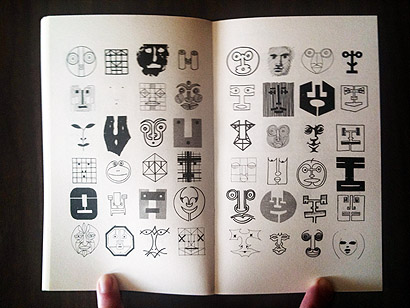
The graphic novel Persepolis, in addition to being a gripping emotional story and the only comic book to ever bring me to tears, is a masterpiece of comic art and a testimony to what you can accomplish through repetition of basic forms. What Persepolis writer/artist Marjane Satrapi can accomplish with a few simple pen strokes is simply astonishing. When the comic was made into an animated movie, Satrapi’s graphic virtuosity survived and indeed thrived in the translation.
Look at these nine faces of girls listening to a political speech from their schoolteacher in Iran, shortly after the 1979 revolution. All of these faces use exactly the same set of design elements: four curved lines (eyebrows, nose, mouth), a pair of football-shaped ovals and dots (eyes), and an amorphous black shape (hairline). And yet each of these girls doesn’t just look completely unique, each has a unique and distinctive personality — earnest, distracted, doubtful.





I was reminded of a book currently on my desk, Bruno Munari’s Design as Art.
In the book’s second section, Munari argues that images can and should have a deliberate “character” in order to be meaningful and memorable to viewers, and that that character is encapsulated in the subtle and not-so-subtle details of a design’s implementation. The design’s style, if you will. What’s more, it doesn’t take much to achieve this character.
To illustrate this, he includes almost 150 simple pen drawings of faces, each one radically different from the last, and each one clearly drawn in only a matter of a few seconds. The illustrator (or illustrators — it doesn’t matter, really) draws on many cultural drawing styles, but even when those seem exhausted new ideas seem to emerge between the stylizations.
It’s a remarkable illustration of the power of small multiples to help push the boundaries of how one thinks about even the simplest design challenge.
It doesn’t take much to make something unique and different. As Munari’s collection of faces shows, simply focusing on variety at the expense of detail and perfection can give rise to some small but powerful and unexpected new ideas.
This is the point of sketching, of course: ingenuity is an emergent property that is more easily produced by turning your attention away from perfecting a single vision.
Satrapi’s faces, of course, are not sketches — their uniqueness is carefully and tenderly crafted through economy of form and the subtlest lines. But they compellingly illustrate that both character and diversity can be found among things whose basic ingredients are essentially identical, whether by accident and spontaneity or through deliberate craft.
As designers, we should be inspired by Munari’s demonstration of how the same question has a thousand solutions, and Satrapi’s revelation that almost the same solution can solve a thousand different problems.


Comments
2 responses to “The Power of Small Multiples”
Do you know 99 ways to tell a story http://www.exercisesinstyle.com/ or the textual work it references, en.wikipedia.org/wiki/Exercises_in_Style ? Brilliant!
@Steve: That’s awesome. It reminds me of Wally Wood’s famous “22 Panels that Always Work”, in which the great comic artist shows 22 different ways to illustrate a single basic narrative moment: people talking.
(click for full size)